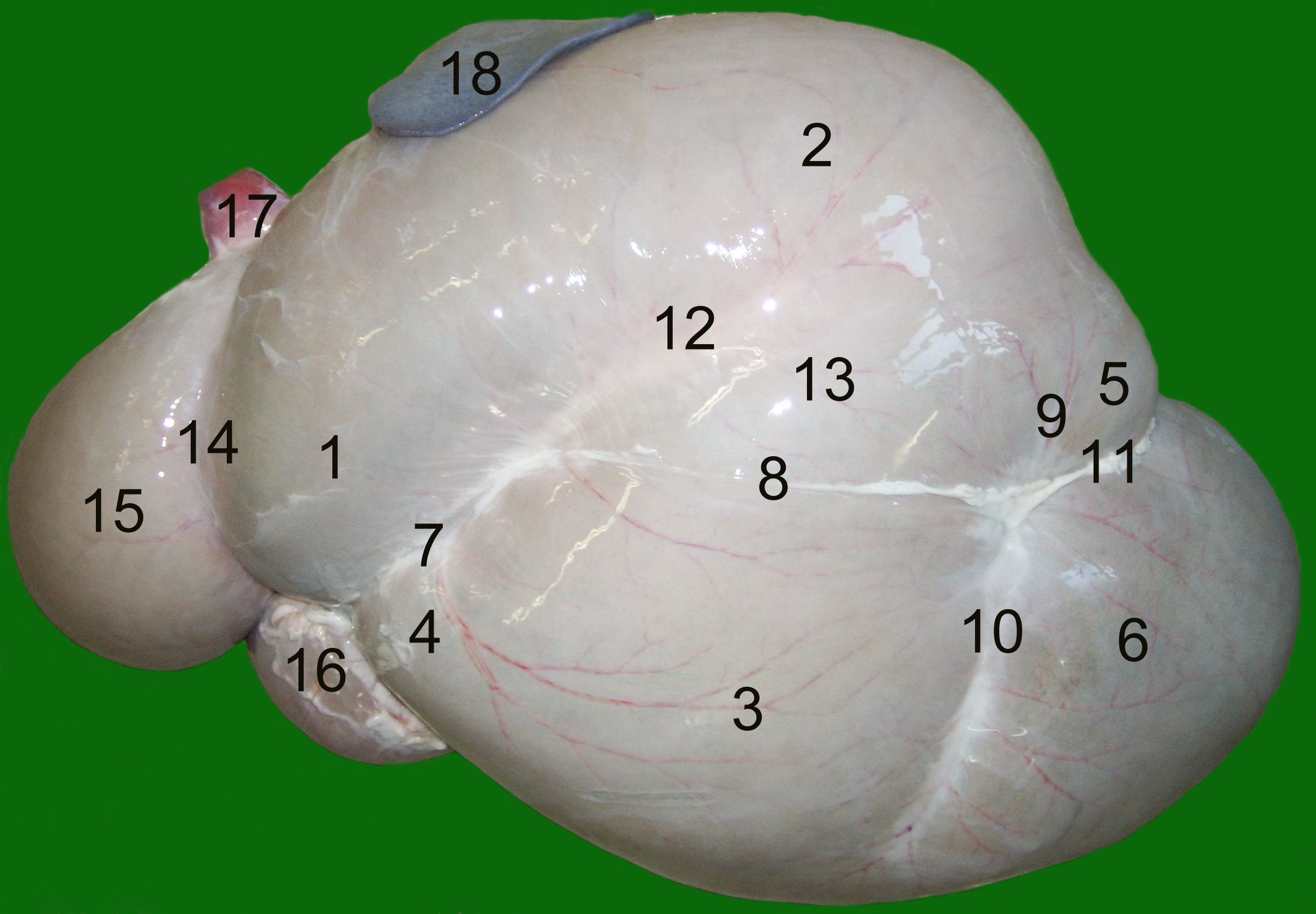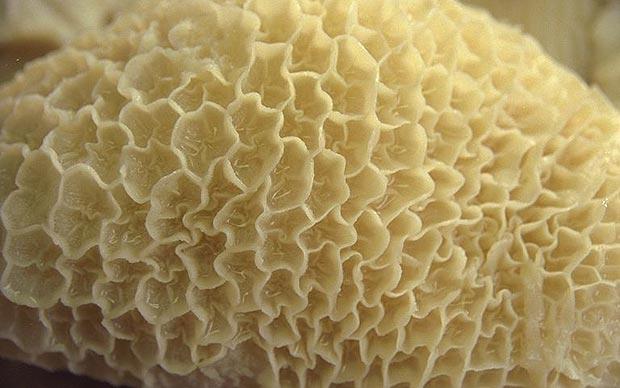|
Omasum
The omasum, also known as the bible, the fardel, the manyplies and the psalterium, is the third compartment of the stomach in ruminants. The omasum comes after the rumen and reticulum and before the abomasum. Different ruminants have different omasum structures and function based on the food that they eat and how they developed through evolution. Anatomy The omasum can be found on the right side of the cranial portion of the rumen. The omasum receives food from the reticulum through the reticulo-omasal orifice and provides food to the abomasum through the omaso-abomasal orifice. The omasum is spherical to crescent shape and has multiple leaflets similar to that of a book called omasal laminae. The omasal laminae are made of thin muscular layers covered with a nonglandular mucous membrane. The omasal laminae come from the sides of the large curvature and project towards the inside of the omasum, extending from the reticulo-omasal orifice to the omaso-abomasal orifice. The lamina ... [...More Info...] [...Related Items...] OR: [Wikipedia] [Google] [Baidu] |
Abomasum (PSF)
The abomasum, also known as the maw,The Chambers Dictionary, Ninth Edition, Chambers Harrap Publishers, 2003 rennet-bag, or reed tripe, is the fourth and final stomach compartment in . It secretes , which is used in creation. The word ''abomasum'' (''ab-'' "away from" + '' [...More Info...] [...Related Items...] OR: [Wikipedia] [Google] [Baidu] |
Ruminants
Ruminants ( suborder Ruminantia) are hoofed herbivorous grazing or browsing mammals that are able to acquire nutrients from plant-based food by fermenting it in a specialized stomach prior to digestion, principally through microbial actions. The process, which takes place in the front part of the digestive system and therefore is called foregut fermentation, typically requires the fermented ingesta (known as cud) to be regurgitated and chewed again. The process of rechewing the cud to further break down plant matter and stimulate digestion is called rumination. The word "ruminant" comes from the Latin ''ruminare'', which means "to chew over again". The roughly 200 species of ruminants include both domestic and wild species. Ruminating mammals include cattle, all domesticated and wild bovines, goats, sheep, giraffes, deer, gazelles, and antelopes.Fowler, M.E. (2010).Medicine and Surgery of Camelids, Ames, Iowa: Wiley-Blackwell. Chapter 1 General Biology and Evolution addresses t ... [...More Info...] [...Related Items...] OR: [Wikipedia] [Google] [Baidu] |
Rumen
The rumen, also known as a paunch, is the largest stomach compartment in ruminants and the larger part of the reticulorumen, which is the first chamber in the alimentary canal of ruminant animals. The rumen's microbial favoring environment allows it to serve as the primary site for microbial fermentation of ingested feed. The smaller part of the reticulorumen is the reticulum, which is fully continuous with the rumen, but differs from it with regard to the texture of its lining. Brief anatomy The rumen is composed of several muscular sacs, the cranial sac, ventral sac, ventral blindsac, and reticulum. The lining of the rumen wall is covered in small fingerlike projections called papillae, which are flattened, approximately 5mm in length and 3mm wide in cattle. The reticulum is lined with ridges that form a hexagonal honeycomb pattern. The ridges are approximately 0.1–0.2mm wide and are raised 5mm above the reticulum wall. The hexagons in the reticulum are approximatel ... [...More Info...] [...Related Items...] OR: [Wikipedia] [Google] [Baidu] |
Methanogens In Digestive Tract Of Ruminants
Methanogens are a group of microorganisms that produce methane as a byproduct of their metabolism. They play an important role in the digestive system of ruminants. The digestive tract of ruminants contains four major parts: rumen, reticulum, omasum and abomasum. The food with saliva first passes to the rumen for breaking into smaller particles and then moves to the reticulum, where the food is broken into further smaller particles. Any indigestible particles are sent back to the rumen for rechewing. The majority of anaerobic microbes assisting the cellulose breakdown occupy the rumen and initiate the fermentation process. The animal absorbs the fatty acids, vitamins and nutrient content on passing the partially digested food from the rumen to the omasum. This decreases the pH level and initiates the release of enzymes for further breakdown of the food which later passes to the abomasum to absorb remaining nutrients before excretion. This process takes about 9–12 hours. Some of th ... [...More Info...] [...Related Items...] OR: [Wikipedia] [Google] [Baidu] |
Reticulum (anatomy)
The reticulum is the second chamber in the four-chamber alimentary canal The gastrointestinal tract (GI tract, digestive tract, alimentary canal) is the tract or passageway of the digestive system that leads from the mouth to the anus. The GI tract contains all the major organs of the digestive system, in humans ... of a ruminant animal. Anatomically it is the smaller portion of the reticulorumen along with the rumen. Together these two compartments make up 84% of the volume of the total stomach. The reticulum is colloquially referred to as the ''honeycomb'', ''bonnet, or ''kings-hood''. When cleaned and used for food, it is called " tripe". Heavy or dense feed and foreign objects will settle here. It is the site of hardware disease in cattle and because of the proximity to the heart this disease can be life-threatening. Anatomy The internal mucosa has a honeycomb shape. When looking at the reticulum with ultrasonography it is a crescent shaped structure with a ... [...More Info...] [...Related Items...] OR: [Wikipedia] [Google] [Baidu] |
Mammal Anatomy
Mammals () are a group of vertebrate animals constituting the class Mammalia (), characterized by the presence of mammary glands which in females produce milk for feeding (nursing) their young, a neocortex (a region of the brain), fur or hair, and three middle ear bones. These characteristics distinguish them from reptiles (including birds) from which they diverged in the Carboniferous, over 300 million years ago. Around 6,400 extant species of mammals have been described divided into 29 orders. The largest orders, in terms of number of species, are the rodents, bats, and Eulipotyphla (hedgehogs, moles, shrews, and others). The next three are the Primates (including humans, apes, monkeys, and others), the Artiodactyla (cetaceans and even-toed ungulates), and the Carnivora (cats, dogs, seals, and others). In terms of cladistics, which reflects evolutionary history, mammals are the only living members of the Synapsida (synapsids); this clade, together with S ... [...More Info...] [...Related Items...] OR: [Wikipedia] [Google] [Baidu] |
Stomach
The stomach is a muscular, hollow organ in the gastrointestinal tract of humans and many other animals, including several invertebrates. The stomach has a dilated structure and functions as a vital organ in the digestive system. The stomach is involved in the gastric phase of digestion, following chewing. It performs a chemical breakdown by means of enzymes and hydrochloric acid. In humans and many other animals, the stomach is located between the oesophagus and the small intestine. The stomach secretes digestive enzymes and gastric acid to aid in food digestion. The pyloric sphincter controls the passage of partially digested food ( chyme) from the stomach into the duodenum, where peristalsis takes over to move this through the rest of intestines. Structure In the human digestive system, the stomach lies between the oesophagus and the duodenum (the first part of the small intestine). It is in the left upper quadrant of the abdominal cavity. The top of the stomach lies ... [...More Info...] [...Related Items...] OR: [Wikipedia] [Google] [Baidu] |
Omasitis
Omasitis is an inflammation of the omasum, the third compartment of the stomach in ruminants. It usually accompanies rumenitis, and is often caused by infection with ''Fusobacterium necrophorum ''Fusobacterium necrophorum'' is a species of bacteria responsible for Lemierre's syndrome and other medical problems. Biology ''F. necrophorum'' is a rod-shaped species of Gram-negative bacteria. It is an obligate anaerobe and is a common inha ...''. References Stomach disorders Inflammations {{Veterinary-med-stub ... [...More Info...] [...Related Items...] OR: [Wikipedia] [Google] [Baidu] |
Dim Sum
Dim sum () is a large range of small Chinese dishes that are traditionally enjoyed in restaurants for brunch. Most modern dim sum dishes are commonly associated with Cantonese cuisine, although dim sum dishes also exist in other Chinese cuisines. In the tenth century, when the city of Canton (Guangzhou) began to experience an increase in commercial travel, many frequented teahouses for small-portion meals with tea called '' yum cha'', or "drink tea" meals. ''Yum cha'' includes two related concepts. The first is " jat zung loeng gin" (), which translates literally as "one cup, two pieces". This refers to the custom of serving teahouse customers two pieces of delicately made food items, savory or sweet, to complement their tea. The second is ''dim sum'' () and translates literally to "touching heart", the term used to designate the small food items that accompanied the tea drinking. Teahouse owners gradually added various snacks called "dim sum" to their offerings. The practice ... [...More Info...] [...Related Items...] OR: [Wikipedia] [Google] [Baidu] |
Larb
''Larb'' ( lo, ລາບ; th, ลาบ, , , also spelled ', ', ' or ') is a type of Lao meat salad that is the national dish of Laos, along with green papaya salad and sticky rice. Larb is also eaten in other Southeast Asian countries where the Lao have migrated and extended their influence. Local variants of ''larb'' also feature in the cuisines of the Tai peoples of Shan State, Burma, and Yunnan Province, China. History Étienne François Aymonier, who visited Laos in 1883, described larb as a favorite dish of Lao people - a mixture of chopped onions or scallions, lemongrass leaves, fermented fish and chili mixed with fresh and boiled fish. The dish was eaten with steam-cooked sticky rice. Another French visitor, doctor Estrade, who arrived in 1893, described larb as a Lao main dish made with boiled fish, chili and ground roasted sticky rice. Depending on the method of preparation, it may be known by different names, including ''nam tok, goi/saa, yum/sua,'' and can be m ... [...More Info...] [...Related Items...] OR: [Wikipedia] [Google] [Baidu] |
Muntjac
Muntjacs ( ), also known as the barking deer or rib-faced deer, (URL is Google Books) are small deer of the genus ''Muntiacus'' native to South Asia and Southeast Asia. Muntjacs are thought to have begun appearing 15–35 million years ago, with remains found in Miocene deposits in France, Germany and Poland. Most species are listed as Least Concern or Data Deficient by the IUCN, although others such as the black muntjac, Bornean yellow muntjac, and giant muntjac are Vulnerable, Near Threatened, and Critically Endangered, respectively. Name The present name is a borrowing of the Latinized form of the Dutch , which was borrowed from the Sundanese ''mēncēk''. The Latin form first appeared as in Zimmerman in 1780. An erroneous alternative name of 'Mastreani deer' has its origins in a mischievous Wikipedia entry from 2011 and is incorrect. Description The present-day species are native to Asia and can be found in India, Sri Lanka, Myanmar, Vietnam, the Indonesia ... [...More Info...] [...Related Items...] OR: [Wikipedia] [Google] [Baidu] |
.png)
.png)




